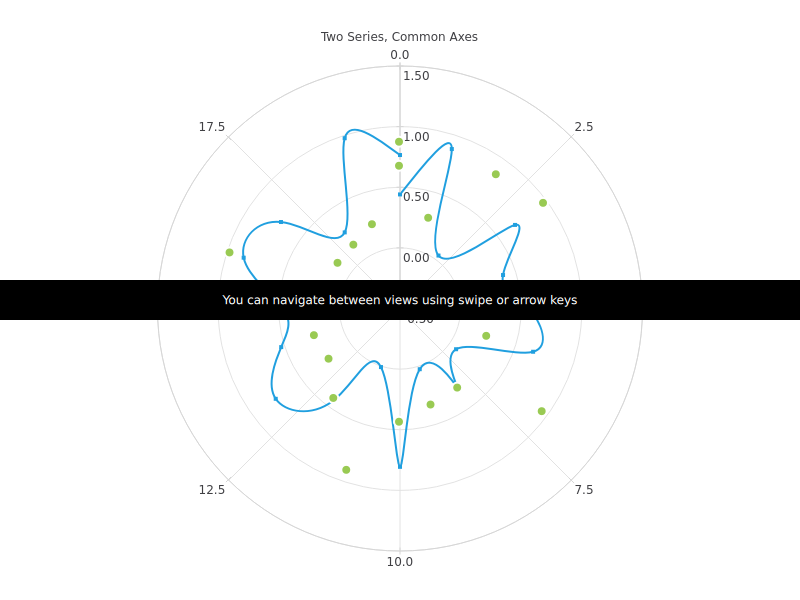QML Polar Chart Example¶
This is a demonstration on how to use a polar chart in your QML application.

// Copyright (C) 2016 The Qt Company Ltd.
// SPDX-License-Identifier: LicenseRef-Qt-Commercial OR BSD-3-Clause
import QtQuick
import QtCharts
Item {
anchors.fill: parent
//![1]
PolarChartView {
title: "Two Series, Common Axes"
anchors.fill: parent
legend.visible: false
antialiasing: true
ValueAxis {
id: axisAngular
min: 0
max: 20
tickCount: 9
}
ValueAxis {
id: axisRadial
min: -0.5
max: 1.5
}
SplineSeries {
id: series1
axisAngular: axisAngular
axisRadial: axisRadial
pointsVisible: true
}
ScatterSeries {
id: series2
axisAngular: axisAngular
axisRadial: axisRadial
markerSize: 10
}
}
// Add data dynamically to the series
Component.onCompleted: {
for (var i = 0; i <= 20; i++) {
series1.append(i, Math.random());
series2.append(i, Math.random());
}
}
//![1]
}
// Copyright (C) 2016 The Qt Company Ltd.
// SPDX-License-Identifier: LicenseRef-Qt-Commercial OR BSD-3-Clause
import QtQuick
import QtCharts
Item {
anchors.fill: parent
//![1]
PolarChartView {
title: "Two Series, Common Axes"
anchors.fill: parent
legend.visible: false
antialiasing: true
ValueAxis {
id: axisAngular
min: 0
max: 20
tickCount: 9
}
ValueAxis {
id: axisRadial
min: -0.5
max: 1.5
}
SplineSeries {
id: series1
axisAngular: axisAngular
axisRadial: axisRadial
pointsVisible: true
}
ScatterSeries {
id: series2
axisAngular: axisAngular
axisRadial: axisRadial
markerSize: 10
}
}
// Add data dynamically to the series
Component.onCompleted: {
for (var i = 0; i <= 20; i++) {
series1.append(i, Math.random());
series2.append(i, Math.random());
}
}
//![1]
}
// Copyright (C) 2016 The Qt Company Ltd.
// SPDX-License-Identifier: LicenseRef-Qt-Commercial OR BSD-3-Clause
import QtQuick
import QtCharts
Item {
anchors.fill: parent
//![1]
PolarChartView {
title: "Historical Area Series"
anchors.fill: parent
legend.visible: false
antialiasing: true
DateTimeAxis {
id: axis1
format: "yyyy MMM"
tickCount: 13
}
ValueAxis {
id: axis2
}
LineSeries {
id: lowerLine
axisAngular: axis1
axisRadial: axis2
// Please note that month in JavaScript months are zero based, so 2 means March
XYPoint { x: toMsecsSinceEpoch(new Date(1950, 0, 1)); y: 15 }
XYPoint { x: toMsecsSinceEpoch(new Date(1962, 4, 1)); y: 35 }
XYPoint { x: toMsecsSinceEpoch(new Date(1970, 0, 1)); y: 50 }
XYPoint { x: toMsecsSinceEpoch(new Date(1978, 2, 1)); y: 75 }
XYPoint { x: toMsecsSinceEpoch(new Date(1987, 11, 1)); y: 102 }
XYPoint { x: toMsecsSinceEpoch(new Date(1992, 1, 1)); y: 132 }
XYPoint { x: toMsecsSinceEpoch(new Date(1998, 7, 1)); y: 100 }
XYPoint { x: toMsecsSinceEpoch(new Date(2002, 4, 1)); y: 120 }
XYPoint { x: toMsecsSinceEpoch(new Date(2012, 8, 1)); y: 140 }
XYPoint { x: toMsecsSinceEpoch(new Date(2013, 5, 1)); y: 150 }
}
LineSeries {
id: upperLine
axisAngular: axis1
axisRadial: axis2
// Please note that month in JavaScript months are zero based, so 2 means March
XYPoint { x: toMsecsSinceEpoch(new Date(1950, 0, 1)); y: 30 }
XYPoint { x: toMsecsSinceEpoch(new Date(1962, 4, 1)); y: 55 }
XYPoint { x: toMsecsSinceEpoch(new Date(1970, 0, 1)); y: 80 }
XYPoint { x: toMsecsSinceEpoch(new Date(1978, 2, 1)); y: 105 }
XYPoint { x: toMsecsSinceEpoch(new Date(1987, 11, 1)); y: 125 }
XYPoint { x: toMsecsSinceEpoch(new Date(1992, 1, 1)); y: 160 }
XYPoint { x: toMsecsSinceEpoch(new Date(1998, 7, 1)); y: 140 }
XYPoint { x: toMsecsSinceEpoch(new Date(2002, 4, 1)); y: 140 }
XYPoint { x: toMsecsSinceEpoch(new Date(2012, 8, 1)); y: 170 }
XYPoint { x: toMsecsSinceEpoch(new Date(2013, 5, 1)); y: 200 }
}
AreaSeries {
axisAngular: axis1
axisRadial: axis2
lowerSeries: lowerLine
upperSeries: upperLine
}
}
// DateTimeAxis is based on QDateTimes so we must convert our JavaScript dates to
// milliseconds since epoch to make them match the DateTimeAxis values
function toMsecsSinceEpoch(date) {
var msecs = date.getTime();
return msecs;
}
//![1]
}
// Copyright (C) 2016 The Qt Company Ltd.
// SPDX-License-Identifier: LicenseRef-Qt-Commercial OR BSD-3-Clause
import QtQuick
import QtCharts
Item {
anchors.fill: parent
//![1]
PolarChartView {
title: "Numerical Data for Dummies"
anchors.fill: parent
legend.visible: false
antialiasing: true
LineSeries {
axisRadial: CategoryAxis {
min: 0
max: 30
CategoryRange {
label: "critical"
endValue: 2
}
CategoryRange {
label: "low"
endValue: 7
}
CategoryRange {
label: "normal"
endValue: 12
}
CategoryRange {
label: "high"
endValue: 18
}
CategoryRange {
label: "extremely high"
endValue: 30
}
}
axisAngular: ValueAxis {
tickCount: 13
}
XYPoint { x: 0; y: 4.3 }
XYPoint { x: 1; y: 4.1 }
XYPoint { x: 2; y: 4.7 }
XYPoint { x: 3; y: 3.9 }
XYPoint { x: 4; y: 5.2 }
XYPoint { x: 5; y: 5.3 }
XYPoint { x: 6; y: 6.1 }
XYPoint { x: 7; y: 7.7 }
XYPoint { x: 8; y: 12.9 }
XYPoint { x: 9; y: 19.2 }
}
}
//![1]
}
// Copyright (C) 2016 The Qt Company Ltd.
// SPDX-License-Identifier: LicenseRef-Qt-Commercial OR BSD-3-Clause
import QtQuick
Item {
width: 800
height: 600
property bool sourceLoaded: false
ListView {
id: root
focus: true
anchors.fill: parent
snapMode: ListView.SnapOneItem
highlightRangeMode: ListView.StrictlyEnforceRange
highlightMoveDuration: 250
orientation: ListView.Horizontal
boundsBehavior: Flickable.StopAtBounds
onCurrentIndexChanged: {
if (infoText.opacity > 0.0) {
if (sourceLoaded)
infoText.opacity = 0.0;
else if (currentIndex != 0)
currentIndex = 0;
}
}
model: ListModel {
ListElement {component: "View1.qml"}
ListElement {component: "View2.qml"}
ListElement {component: "View3.qml"}
}
delegate: Loader {
width: root.width
height: root.height
source: component
asynchronous: true
onLoaded: sourceLoaded = true
}
}
Rectangle {
id: infoText
anchors.centerIn: parent
width: parent.width
height: 40
color: "black"
Text {
color: "white"
anchors.centerIn: parent
text: "You can navigate between views using swipe or arrow keys"
}
Behavior on opacity {
NumberAnimation { duration: 400 }
}
}
}
# Copyright (C) 2022 The Qt Company Ltd.
# SPDX-License-Identifier: LicenseRef-Qt-Commercial OR BSD-3-Clause
from __future__ import annotations
"""PySide6 port of the QML Polar Chart Example from Qt v5.x"""
import os
from pathlib import Path
import sys
from PySide6.QtQuick import QQuickView
from PySide6.QtCore import QUrl
from PySide6.QtWidgets import QApplication
if __name__ == '__main__':
app = QApplication(sys.argv)
viewer = QQuickView()
src_dir = Path(__file__).resolve().parent
viewer.engine().addImportPath(os.fspath(src_dir))
viewer.engine().quit.connect(viewer.close)
viewer.setTitle = "QML Polar Chart"
viewer.setSource(QUrl.fromLocalFile(src_dir / 'main.qml'))
viewer.setResizeMode(QQuickView.SizeRootObjectToView)
viewer.show()
sys.exit(app.exec())